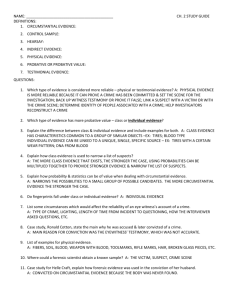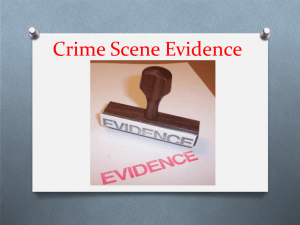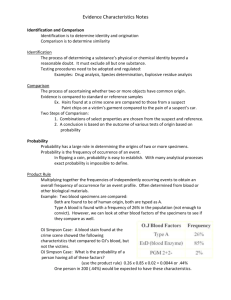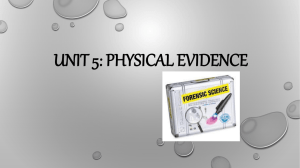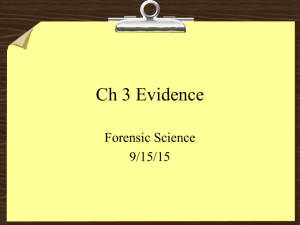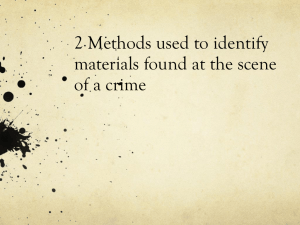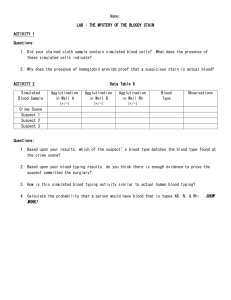The Nature of Evidence
advertisement
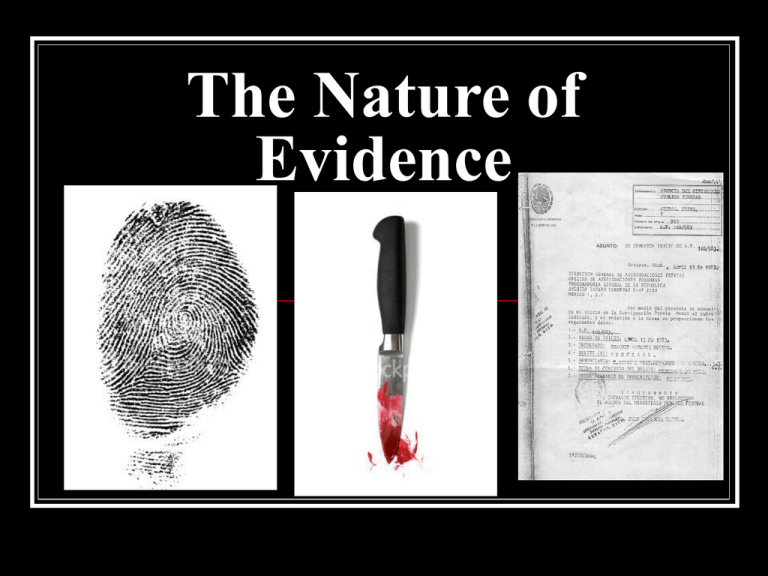
The Nature of Evidence What is Evidence? Evidence is information in the form of: Personal testimony (testimonial evidence) Text of documents Material objects Used to make a fact or proposition more or less likely “Trier-of-fact” is whoever determines guilt or innocence (jury or judge) Forensics as Historical Science Forensics Archaeology Geology Time Frame Hours, days, months Hundreds to thousands of years Millions of years Activity Level Personal; individual Social; populations Global Proxy Data Mass-produced Hand-made Natural Earliest record of physical evidence Archimedes (287-212 BC) shows that a crown give to the king was made of a goldsilver allow rather than pure gold Common types of physical evidence (name some) drugs, toxic substances paints gunshot or explosive residues firearms and ammunition shoeprints petroleum products alcohols rubber material resins, plastics serial numbers documents tool marks fibers, hair soil glass blood bite marks fingerprints body tissue pollen wood feathers bones body fluids Real vs demonstrative evidence Real evidence is generated as part of the crime; recovered from the victim, suspect, or place the crime was committed Hair, blood, paint, footprints, bullets Demonstrative evidence was not generated directly but was created later to explain the significance of real evidence Charts, computer simulations, DNA testing methods Varieties of evidence (see handout) Circumstantial Conclusive Conflicting Corroborating Derivative Exculpatory Foundational Hearsay Incriminating Presumptive Prima facie Probative Rebuttal Tainted Why do we say that forensic science is an historical science? Events that occurred are already in the past We only see proxy data (remnants of the event) Similar to other historical sciences Transfer and Persistence A central guiding theory of forensic science Developed by Edmund Locard (early 20th century) An exchange of information occurs even if it is too small to be found All evidence is transfer evidence Locard’s Principle Every contact produces some level of exchange Any transfer that occurs after the crime is considered contamination What are some of the conditions that affect transfer? Pressure Number of contacts Ease of transfer Form of evidence How much transferred Direct vs indirect (you will understand this intuitively) Persistence: how long evidence remains Depends on: What it is Location Environment Time Activity around site of collection www.uiowa.edu/.../drybones/images/2-9.jpg Identification Chemical and physical properties of the object or material Is this white powder cocaine or talc? Determining that a colored chip is automotive paint The hair comes from a cocker spaniel Identification allows the object to be classified – class evidence Two objects sharing a class identity may come from a common source Fibers on a body and fibers in the suspect’s car Paint flecks on the victim(s) and paint used by suspect in his work (Green River killer) Read article about the case The best evidence is individual evidence Anything that can be linked to a unique source, i.e. a class with one member Includes fingerprints, DNA patterns, handwriting Can be physical matches (toenail in the 1st CSI episode) The forensic scientists main goal is to find a unique source of the evidence Or, common feature in unique combination Unique fingerprint Relationship and Context Relationships between people and places are critical to determining the relevance of evidence Example: Co-habitation creates unavoidable transfers of some types of evidence Coincidental association – stranger-on-stranger Studies show this is very rare because of huge variety of goods and consumer choices Direct vs Indirect evidence Prima facie evidence is direct evidence – “I saw him steal the tomato.” Most evidence does not prove a fact and is called indirect evidence Some physical evidence proves something (person has possession of a drug or an elevated blood alcohol level) but may not necessarily prove guilt or innocence Circumstantial evidence implies a fact or event without proving it The more circumstantial evidence there is the greater weight it carries Probability and statistics are important Example: blond hair in dark-haired victim’s hand, footprint of size 11 running shoe near body Suspect is blond and wears size 11 The case against suspect is stronger than if only one or the other piece of evidence existed Probative means supplying proof Finding many different types of class evidence linking suspect to crime or victim increases the probative value of the evidence Probative evidence need not always be individual evidence Probative evidence can prove or disprove a hypothesis Things you should be able to do 1. 2. 3. 4. State Locard’s Principle Describe what is meant by physical evidence and give examples Tell individual evidence apart from class evidence Determine the significance of class evidence
